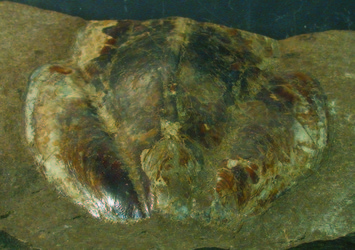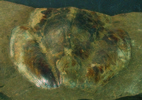Teudopseina
Dirk Fuchs
- Teudopsidae Regteren Altena, 1949

- Trachyteuthididae Naef, 1921

- Palaeololiginidae Naef, 1921

- Münsterellidae Roger, 1952

Introduction
The Teudopseina represents the largest group of Mesozoic gladius bearing coleoids. Evolutionary transformations of their gladius are very well documented in the fossil record. Four families are currently known ranging from the early Toarcian to the latest Cretaceous: Teudopsidae, Trachyteuthididae, Muensterellidae, and Palaeololiginidae. Most characteristic is their anteriorly rounded or pointed median field. The gladius of the latter three families can be easily derived from the Teudopsidae.


Figure: Selection of teudopseid gladii. A) Teudopsis subcostata (Teudopsidae, early Jurassic), B) Trachyteuthis teudopsiformis (Trachyteuthididae, late Jurassic), C) Glyphiteuthis libanotica (Trachyteuthididae, late Cretaceous), D) Actinosepia canadensis (Trachyteuthididae, late Cretaceous), E) Teudopsis bollensis (Teudopsidae, early Jurassic), F) Teudopsis buneli (Teudopsidae, early Jurassic), G) Palaeololigo oblonga (Palaeololiginidae, late Jurassic), H) Muensterella scutellaris (Muensterellidae, late Jurassic), I) Teudopsinia haasi (Teudopsidae, late Cretaceous) © Dirk Fuchs
Preserved arm crows are known from a number of species from different families (Trachyteuthis hastiformis, Glyphiteuthis libanotica, Glyphiteuthis abisaadiorum, Palaeololigo oblonga, Rachiteuthis donovani, Muensterella scutellaris). None of them display more than eight arms. The most abundant and therefore best known species is Trachyteuthis hastiformis.
Haas (2002), Bizikov (2004, 2008), Fuchs (2009), Fuchs et al. (2009; in press) and Fuchs & Weis (2009, in press) regarded the Teudopseina to be a stem-group of the Octopoda.
Characteristics
- Gladius
- Conus strongly reduced (spoon-shaped).
- Median field anteriorly distinctly rounded or pointed.
- Hyperbolar zones weakly curved, less than 60% of the median field length.
- Lateral fields shorter than the hyperbolar zones.
Classification
- Teudopsidae Regteren Altena, 1949
- Teudopsis Eudes-Deslongchamps, 1835 (Toarcian)
- Teudopsis bunelii Eudes-Deslongchamps, 1835**
- Teudopsis bollensis Voltz, 1836****
- Teudopsis subcostata (Münster, 1843)****
- Teudopsis cadominensis Hall & Neumann, 1989*
- Teudopsis jeletzkyi Riccardi, 2005*
- Teudopsinia Fuchs in press (Cenomanian)
- Teudopsinia haasi Fuchs in press*
- Styloteuthis Fritsch, 1910 (Turonian)
- Styloteuthis convexa Fritsch, 1910*
- Trachyteuthididae Naef, 1921
- Trachyteuthis Meyer, 1846 (Oxfordian – Cenomanian)
- Trachyteuthis hastiformis (Rüppell, 1829)****
- Trachyteuthis latipinnis (Owen, 1855)**
- Trachyteuthis zhuravlevi Hecker & Hecker, 1955*
- Trachyteuthis covacevichi Fuchs & Schultze, 2008**
- Trachyteuthis palmeri (Schevill, 1950)*
- Trachyteuthis nusplingensis Fuchs et al. 2007**
- Trachyteuthis teudopsiformis Fuchs et al. 2007**
- Trachyteuthis willisi Wade, 1993**
- Trachyteuthis sp.* (Heligoland)
- Trachyteuthis sp. Fuchs 2006** (Hakel)
- Glyphiteuthis Reuss, 1854 (Cenomanian – Santonian)
- Glyphiteuthis ornata Reuss, 1854**
- Glyphiteuthis boutillieri (Lennier, 1866)*
- Glyphiteuthis rhinophora Fuchs et al. in revision*
- Glyphiteuthis abisaadiorum Fuchs & Weis, 2009****
- Glyphiteuthis libanotica (Fraas, 1878)****
- Glyphiteuthis sp. Fuchs in preparation** (Hakel)
- Glyphidopsis Fuchs in preparation (Cenomanian)
- Glyphidopsis sp. Fuchs in preparation* (Hakel)
- Actinosepia Whiteaves, 1897 (Campanian– Maastrichtian)
- Actinosepia canadensis Whiteaves, 1897***
- Actinosepia sp. (South Dakota)***
- Palaeololiginidae Naef, 1921
- Palaeololigo Naef, 1921 (Tithonian)
- Palaeololigo oblonga Wagner, 1859**
- Rachiteuthis Fuchs, 2006 (Cenomanian)
- Rachiteuthis donovani Fuchs, 2006****
- Marekites Kostak, 2002
- Marekites vinarensis (Fritsch, 1910)*
- Münsterellidae Roger, 1952
- Muensterella Schevill, 1950 (Tithonian - Albian)
- Muensterella scutellaris Muenster, 1842****
- Muensterella tonii Wade, 1993*
- Celaenoteuthis Naef, 1922 (Tithonian)
- Celaenoteuthis incerta Naef, 1922**
- Enchoteuthis Miller & Walker, 1968 (Albian – Campanian)
- Enchoteuthis melanae Miller & Walker, 1968**
- Enchoteuthis sp. (Queensland)
- Enchoteuthis sp. (South Dakota)
Problematic muensterellids
- ?Tusoteuthis longa Logan, 1898*
- ?Kansasteuthis lindneri Miller & Walker, 1968*
- ?Niobrarateuthis bonneri Miller, 1957*
- ?Niobrarateuthis walkeri Green, 1977*
(*only 1 specimen known; ** 2-5 specimens; *** 5-10 specimens; **** > 10 specimens)
References
Bizikov, V.A. 2004. The shell in Vampyropoda (Cephalopoda): morphology, functional role and evolution. Ruthenica supplement 3: 1-88.
Bizikov, V.A. 2008. Evolution of the shell in cephalopoda. 447 p., Moscow (VNIRO Publishing).
Fuchs, D. 2006a. Fossil erhaltungsfähige Merkmalskomplexe der Coleoidea (Cephalopoda) und ihre phylogenetische Bedeutung. Berliner Paläobiologische Abhandlungen 8: 1-115.
Fuchs, D. 2006b. Diversity, Taxonomy and Morphology of vampyropod Coleoids (Cephalopoda) from the Upper Cretaceous of Lebanon. Memorie della Società Italiana di Scienze Naturali et del Museo Civico di Storia Naturale di Milano 34(II): 1-28.
Fuchs, D. 2009. Octobrachia - a diphyletic origin? Berliner Paläobiologische Abhandlungen 10: 182-192.
Fuchs, D. (in press). A rare and unusual teudopseid coleoid from the Late Cretaceous of Hâqel (Lebanon). In: Fuchs, D., Weis, R. & Faber, A., eds., Proceedings of the 3rd International Symposium Coleoid Cephalopods Through Time. Luxembourg 2008. Ferrantia, Musée national d'histoire naturelle Luxemburg.
Fuchs, D., Bracchi, G. & Weis, R. 2009. New records of octopods (Cephalopoda: Coleoidea) from the Late Cretaceous (Upper Cenomanian) of Hakel and Hadjoula (Lebanon). Paleontology 52(1): 56-81.
Fuchs, D., Engeser, T., & Keupp, H. 2007. Gladius shape variation in the genus Trachyteuthis Meyer 1846 (Cephalopoda: Coleoidea) from the Late Jurassic Plattenkalks of Nusplingen (Kimmeridgian) and Solnhofen (Tithonian). Acta Palaeontologica Polonica 52(3): 575-589.
Fuchs, D., Stinnesbeck, W., Ifrim, C., Giersch, S., Gutierrez, J.M.P. & Frey, E. (in press). Glyphiteuthis rhinophora n. sp., a trachyteuthidid (Coleoidea, Cephalopoda) from the Cenomanian (Late Cretaceous) of Mexico. Paläontologische Zeitschrift.
Fuchs, D. & Weis, R. 2009. A new Cenomanian (Late Cretaceous) coleoid (Cephalopoda) from Hâdjoula, Lebanon. Fossil Record 12(2): 175-181.
Fuchs, D. & Weis, R. (in press). Taxonomy, morphology and phylogeny of Lower Jurassic teudopseid coleoids (Cephalopoda). Neues Jahrbuch für Geologie und Paläontologie.
Haas, W. 2002. The evolutionary history of the eight-armed Coleoidea. Abhandlungen der Geologischen Bundesanstalt 57: 341-351.
Title Illustrations

| Scientific Name | Teudopsis subcostata |
|---|---|
| Specimen Condition | Fossil -- Period: Toarcian (Early Jurassic) |
| Identified By | D. Fuchs |
| View | Dorsoposterior |
| Image Use |
 This media file is licensed under the Creative Commons Attribution-NonCommercial License - Version 3.0. This media file is licensed under the Creative Commons Attribution-NonCommercial License - Version 3.0.
|
| Copyright |
© Dirk Fuchs

|
About This Page
Dirk Fuchs

Hokkaido University
Correspondence regarding this page should be directed to Dirk Fuchs at
Page copyright © 2010 Dirk Fuchs
 Page: Tree of Life
Teudopseina.
Authored by
Dirk Fuchs.
The TEXT of this page is licensed under the
Creative Commons Attribution-NonCommercial License - Version 3.0. Note that images and other media
featured on this page are each governed by their own license, and they may or may not be available
for reuse. Click on an image or a media link to access the media data window, which provides the
relevant licensing information. For the general terms and conditions of ToL material reuse and
redistribution, please see the Tree of Life Copyright
Policies.
Page: Tree of Life
Teudopseina.
Authored by
Dirk Fuchs.
The TEXT of this page is licensed under the
Creative Commons Attribution-NonCommercial License - Version 3.0. Note that images and other media
featured on this page are each governed by their own license, and they may or may not be available
for reuse. Click on an image or a media link to access the media data window, which provides the
relevant licensing information. For the general terms and conditions of ToL material reuse and
redistribution, please see the Tree of Life Copyright
Policies.
- First online 03 May 2010
- Content changed 03 May 2010
Citing this page:
Fuchs, Dirk. 2010. Teudopseina. Version 03 May 2010 (under construction). http://tolweb.org/Teudopseina/140241/2010.05.03 in The Tree of Life Web Project, http://tolweb.org/








 Go to quick links
Go to quick search
Go to navigation for this section of the ToL site
Go to detailed links for the ToL site
Go to quick links
Go to quick search
Go to navigation for this section of the ToL site
Go to detailed links for the ToL site